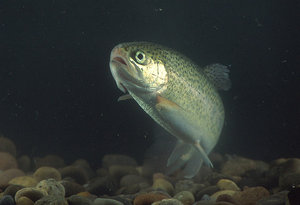Trout is the common name given to a number of species of freshwater fishes belonging to the salmon family, Salmonidae.
All fish properly called trout are members of the subfamily Salmoninae, but the name is used for fish from all three genera in the subfamily: Salmo, which includes Atlantic species; Oncorhynchus, which includes Pacific species; and Salvelinus, which includes fish typically referred to as Char.
Trout are usually found in cool, clear streams and lakes, and are distributed naturally throughout North America, northern Asia and Europe. Several species of trout were introduced to Australia and New Zealand by amateur fishing enthusiasts in the 19th century, contributing to the displacement of native freshwater fish to some extent.
Trout have no spines on the fins, and all of them have a small adipose (fatty) fin along the back, near the tail. There are many species, and even more populations that are isolated from each other and morphologically different. However, many of these distinct appearing populations show no significant genetic differences, and therefore what appear to be a large number of species are considered a much smaller number of distinct species by most ichthyologists.
The trout found in the eastern United States are a good example of this. The brook trout, the aurora trout and the (extinct) silver trout all have physical characteristics and colourations that distinguish them. Genetic analysis shows however that they are one species, Salvelinus fontinalis.
Other fish that are part of this group include the rainbow, lake, bull, brown, and cutthroat trouts. Lake trout (like Brook trout - Salvelinus fontinalis) are actually a member of the char family Salvelinus namaycush. It inhabits many of the larger lakes in North America and lives much longer than Rainbow trout which has an average maximum life span of 7 years. Lake trout can live many decades and can grow to more than 60 pounds.
Most trout are restricted to freshwater, but many, like the steelhead (Oncorhynchus mykiss) – which is the same species as the landlocked rainbow trout – spend their adult life in the ocean and then return to spawn in the streams in which they were hatched. This is called anadromous reproduction and is more often seen in salmon. Brook trout, Brown trout, Cutthroat trout, Bull trout, and Arctic Char all have populations that run to salt water. Trout generally feed on soft bodied aquatic invertebrates, such as Diptera, mayfly, caddis fly, and stonefly, although larger specimens of trout regularly feed on other fish.
As a group, trout are a somewhat bony fish, but the flesh is considered good eating. Additionally, they provide a good fight when caught with a hook and line, and are sought after recreationally. Because of their popularity, trout are often raised on fish farms and introduced into the streams that are most heavily fished. While they can be caught with a normal rod and reel, fly fishing is a distinctive method developed primarily for trout and now extended to other species.
Kinds of trout include: the brown trout Salmo trutta, brook trout Salvelinus fontinalis, cutthroat trout Onchorhynchus clarki, rainbow trout Oncorhynchus mykiss, golden trout Oncorhynchus aguabonita.
The cutthroat trout has 14 recognized subspecies (depending on your sources), such as the Lahontan cutthroat trout Oncorhynchus clarki henshawi, Bonneville cutthroat trout Oncorhynchus clarki utah, Colorado River cutthroat trout, Yellowstone cutthroat trout
References
- Trout and Salmon of North America, Robert J. Behnke, Illustrated by Joseph R. Tomelleri, The Free Press, 2002, hardcover, 359 pages, ISBN 0-7432-2220-2


